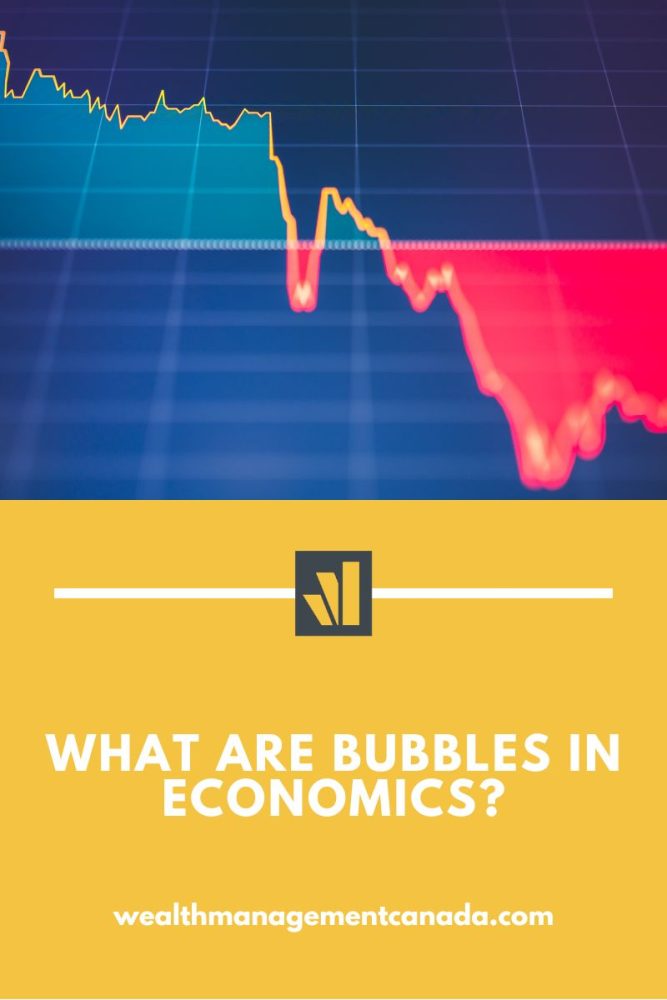You may have heard the term “economic bubble” at some point in your investing journey. But what are bubbles in economics and why should you be concerned with them? The long and short of the matter is economic bubbles arise when the perceived value of a commodity exceeds its real value greatly. This typically occurs over a short period of time and is a result of over-excitement or disproportionate hype. To learn more about economic bubbles, keep reading!

Table of contents
What are bubbles in the economy?
An economic bubble occurs anytime the price of a product or service rises well above the good’s real value. At first, the price of the product is over-inflated, but eventually, resources and perceptions change in the market resulting in deflation. Bubbles in the economy are almost always driven by changes in investor behavior. However, what causes this change in behavior remains to be up for debate by experts.
Related Reading: Understanding the Relationship Between Our Economy and the Stock Market

START WORKING WITH A WEALTH MANAGER NOW
How a bubble is formed in economics
As mentioned above, bubbles in the economy are formed by changes in investor behavior. This means that perceptions around the value of a product changes, resulting in a perceived greater value than true worth.
A classic example of an economic bubble is the dot com bubble of the late 1990s. At the time, the internet was in its infancy, but beginning to gain widespread interest. As a result, investors rapidly entered the market and invested in the World Wide Web. Perceptions evolved to believe that dot com startups were worth more than they actually were. But in March 2000, the bubble burst because the underlying value was not as high as investors perceived. This resulted in online shopping companies to fail and shut down. Those that survived had to greatly reduce their costs to stay afloat.
Ultimately, bubbles are formed in economics over hype or distortions in a market. While much of economics is based around numbers and logic, we can never entirely eliminate human behavior and perception! Investors are human too and they don’t always make the most rational decisions. Sometimes, they are influenced by emotions, like excitement, fear and greed. This is why markets don’t perform perfectly over time and are subject to booms, busts and bubbles.
What causes bubbles to burst in economics?
Economic bubbles are first created by overvaluing a product. But eventually, the overvaluation is realized and the bubble bursts. It is impossible for an overvaluation of a product to perpetuate forever. So, when the overvaluation is eventually realized, the bubble in the economy bursts.
Related Reading: Price to Book Value Ratio: How to Use it for Your Next Investment
What is an example of a price bubble?
The dot com bubble mentioned above is one of many examples of a price bubble. Another classic example from recent history is the 2008 Financial Crisis. Although, this was a unique kind of economic bubble. There was a misconception in the market that perpetuated for quite some time that “everyone always pays their mortgage”. This led to banks creating mortgage backed securities and filling them with subprime mortgages.
After some time, there weren’t enough mortgages to create more mortgage backed securities, so banks became more lenient with who they extended mortgages to. This meant abandoning basic financing principles like income verification and credit checks. Eventually, the value of homes were inflated because the people being extended mortgages couldn’t actually afford them.
In the end, the bubble was caused by extensive risk taken on by banks. They believed that housing was worth more than it was, simply because of the notion that “everyone always pays their mortgage” without actually verifying that this was true. Furthermore, the housing market was not behaving in a way that it should be. Mainly, people shouldn’t be able to buy homes if they can’t afford it – especially not several properties. In addition, banks shouldn’t have leveraged mortgages to create more money if the underlying asset was not valued correctly, which it wasn’t.
What was the first economic bubble?
The first economic bubble recorded in human history was tulipmania from 1634 to 1638. This is also one of the most famous examples of a bubble in the economy. It occurred in Holland where people are known for their love of flowers. The Dutch introduced a variety of tulips to Holland based on their species and coloring.
Overtime, the hype and interest over tulips inflated causing the price of bulbs to skyrocket. It got so bad that people even mortgaged their homes and other industries just to purchase a tulip bulb! Although, it was short lived. Eventually consumers didn’t care as much about tulips and the market crashed. Unfortunately, those who had previously purchased tulip bulbs couldn’t sell them for what they paid, resulting in disastrous losses.
Related Reading: Guiding Canadians Through the Wealth Management Industry
What is the problem with bubbles in economics?
Any given market functions best when the perceived value and actual value are close. However, when there is a difference between the two, it does create an opportunity for investors. Although, this is mainly when the perceived value is lower than the actual value. When the perceived value aligns or supersedes with the actual value, the investor earns a profit.
On the other hand, when the perceived value is higher than the actual value, that’s when an economic bubble occurs and problems arise. This means an investor pays more than the real value of an asset, which eventually leads to a loss.
Further, the bigger an economic bubble is, the more disastrous the loss is. The loss can be widespread and seeps into other areas of the economy, as seen with the 2008 Financial Crisis. To summarize, a market functions best when the real and perceived value is close together. So, when economic bubbles occur, it can cause big problems.
Are we in a credit bubble?
Many investors, economists and consumers have expressed worry over Canada’s economic state. There are concerns over an undisclosed recession, the government potentially printing money, and generally unstable economic conditions. Another concern is over a potential credit bubble.
A credit bubble is a relatively new phenomenon. It is a type of economic bubble that is created by the expansion of credit that is not backed by collateral, like credit cards and unsecured lines of credit. This type of debt has higher interest to accommodate for the level of risk being taken on by lenders. However, there is no guarantee that debtors will repay the debt plus interest. But despite this, creditors continue to extend unsecured debt to borrowers in a way that is not economically sound.
In other words, lenders are overvaluing unsecured debt and making assumptions that borrowers will repay the principal plus interest. But there is only so much money in the economy and borrowers may be unable to repay all the debts extended to them. This is especially true since attitudes towards credit and spending have changed over the past one or two decades. Meaning, some borrowers are exploiting credit with no intention of repaying. As a result, the value of unsecured debt to lenders is overvalued causing an economic bubble that may burst.
Many feel that North America is experiencing some kind of credit bubble, but no one can say for sure. We may find out over the next few years if it bursts!
Related Reading: Inflation and the Market: How do they interact?
How do you identify a market bubble?
In theory, you can identify a market bubble by assessing the real and perceived value of a product. If the perceived value significantly exceeds the real value, an economic bubble exists in the market. Often, this is a strategy short sellers employ to make bets against the performance of an investment.
Although, this is easier to relay in theory than in practice, as with most things! Determining these values means having access to certain information and being in a position where you can look at markets from a vantage point. Typically, only those who are already actively involved in a market can identify bubbles. And even if they do successfully identify an economic bubble, they might be swayed by the hype or influences around them. It takes experience and knowledge to effectively predict a market bubble.
Economic Bubbles and Your Investments
Economic bubbles can influence the value of your investments both directly and indirectly. For this reason, it’s important to pay attention to what’s going on in a market and exercise scrutiny where applicable. Moreover, it’s important to remain calm and rational when making financial decisions so you’re not swept upwards into an economic bubble. We hope this article effectively educated you on the concept of what are bubbles in economics and you can utilize it towards your investing decisions!
Read More: Is Cryptocurrency a Ponzi Scheme?